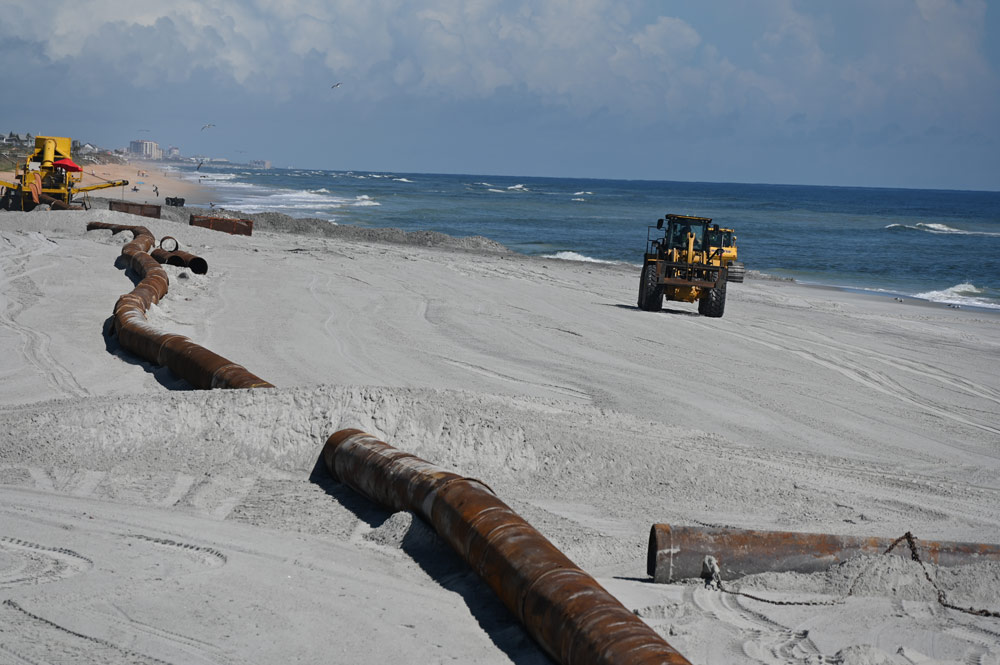
Flagler County government’s proposed $114 million plan to rebuild, maintain and protect 18 miles of shoreline over the next six years depends on raising the local sales tax by half a penny, imposing a $160-a-year tax on each barrier island property, including Flagler Beach, doubling spending on the beach from the county’s tourism-tax revenue, and temporarily using some general fund revenue toward the effort.
The plan requires more of a political than a financial buy-in from Palm Coast, Flagler Beach, Bunnell, Beverly Beach and Marineland. Aside from the barrier-island tax, or fee, it makes no demands on the cities’ property-tax revenue. But it would require Flagler Beach, Beverly Beach and Marineland to cede to beach management all their share of the revenue from the new half-cent sales tax, and require Palm Coast and Bunnell to ceded half their share of that revenue. The cities’ share of the current sales tax would not be affected.
At a joint meeting of local governments on Feb. 5 Palm Coast and Beverly Beach, and to some extent Flagler Beach, bluntly rejected the county’s request for financial help to rebuild and maintain Flagler County’s beaches. County officials at that meeting said they had a financial plan to get it all done. But they did not present it. (See: “Eroding Management Plan, Cities Bluntly Tell Flagler County: Not One Extra Dime for Beach Protection.”)
County Administrator Heidi Petito and Deputy County Administrator Jorge Salinas now have that plan down to the dollar. Petito and Salinas presented the plan to the Marineland Town Commission last Thursday. They are presenting it to the Bunnell City Commission tonight, the Palm Coast City Council on Tuesday, and the Flagler Beach City Commission on Thursday. The County Commission has yet to see it as a commission. But the plan, Petito said, is the result of the commission explicitly directing the administration to come up with concrete and pragmatic options to finance the county’s beach management while taking account of residents and municipalities’ resistance to new taxes.
The result is a thoughtful, detailed approach that attempts to balance the large financial cost of protecting the county’s primary economic asset–the beach–with local governments’ own burdens. The plan would relieve all the cities of any beach-management responsibility, especially Flagler Beach, making the county responsible for management of all 18 miles of shoreline. The county would carry the largest financial burden and the only managerial burden. But the varied funding mechanism seeks to spread some of the financial pain around through existing and novel means, while leaving all the cities’ property taxes (or general funds) untouched.
“As a county, people need to come together and support it,” Petito said of the plan. “Doing nothing is an option. Not a smart option, but it is an option.” So if the cities do not support the plan, the county will simply go ahead with rebuilding and maintaining the unincorporated part of the beach to the extent possible, which may not be as substantial as if the whole County was on board. As for Flagler Beach, its now beloved beach-renourishment section south of the pier, completed by the U.S. Army Corps of Engineers last summer, would be a one-off thing instead of a 50-year, ongoing project.
Maintaining that renourished beach is Flagler Beach’s responsibility. The city has yet to come up with a plan to do so, or to come up with part of the local match to fund the next round in 2030. The Petito plan gives the city an out. It makes the county responsible for it all.
If Flagler Beach declines, there is no money for the next beach nourishment round in Flagler Beach, due in 2030. The 50-year plan by the U.S. Army Corps of Engineers would just die. The beach would not be far behind.
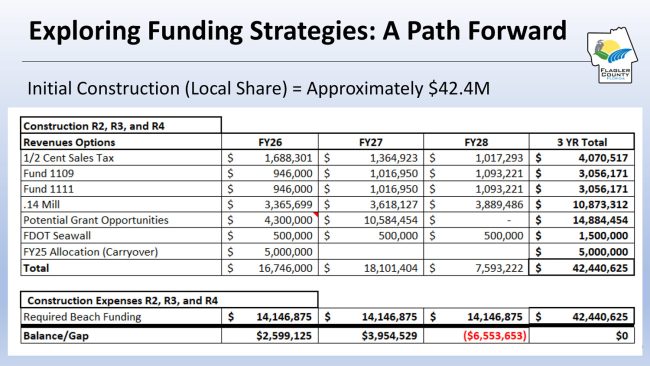
The Petito plan has many layers and can seem complex, but broken down into its component parts, it’s rather straight-forward.
There are two components to beach management. Beach renourishment is one. That’s what’s often referred to as the “construction” part of rebuilding a beach–the literal dredging and dumping of new sand and rebuilding of dunes, the way the Army Corps did in Flagler Beach.
That phase would cost $42.4 million. It is necessary because since Hurricane Matthew, the beaches have been critically eroded in several parts, and without sea walls–which the state Department of Transportation has installed or is installing in two segments–erosion will continue, endangering A1A, which has been repeatedly bruised in severe storms, and flooding the barrier island, as was the case during Matthew, when dunes breached. The county cannot afford to lose the economic base of the island, Petito says, or else every local government’s services and quality of life would suffer.
“What we are trying to get back to is the pre-Matthew conditions,” the county administrator says. “Right now Flagler County is more vulnerable than when Hurricane Matthew hit,” she told the Marineland Town Commission. That may be true in some segments of the shoreline, but not in others–not in the Army Corps segment in Flagler Beach, for example, and not along the segment of northern Flagler Beach where the state built a seawall. Elsewhere, Petito is correct: the band-aid emergency sand dumps the county conducted since Matthew have themselves eroded.
The county would carry out that re-construction phase from north of the Flagler Beach pier all the way to Marineland. The cost for that phase is $42 million. The county is willing to shoulder the full cost. It would do so through its share of the existing sales tax, through tourist tax revenue, through the general fund, which would devote between $3.3 million and $3.9 million a year over the next three years to the plan, and through state and federal grants. The county already has $7.4 million of those pledged.
Doubling the tourism tax revenue for beach management may be a challenge, because it depends on re-allocating nearly $1 million a year, for just three years, from the tourism capital fund–which has funded grants for Palm Coast’s Southern Recreation center and Flagler Beach’s boardwalk reconstruction–to beach management only. That means there would be no grants for capital improvements for a while.
The cities might complain. But as far as rebuilding all the beaches are concerned, the cities would not have to put up a dime.
Then comes the maintenance part. That phase would cost $72.1 million. “We can do the construction but when it comes to maintenance, everyone has to have skin in the game,” Petito says.
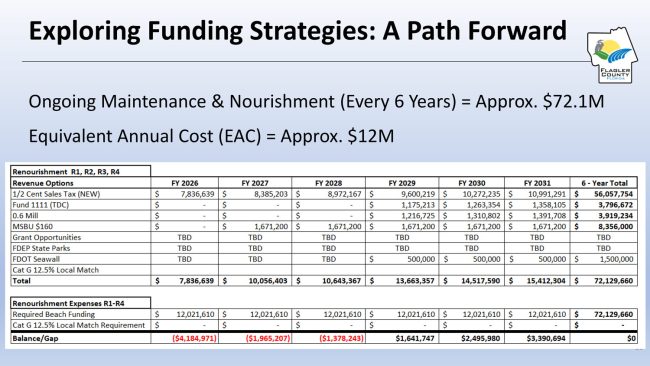
That’s the part where the cities have to be more engaged. That’s the part that requires an additional $12 million a year, so there’s enough money to maintain the beach and accumulate savings for the next renourishment phase in staggered years, starting in 2030. That’s the part for which the Petito plan calls for an additional half-cent sales tax.
Flagler County is the last small county in Florida not to have that half-cent on its books. It would generate $10.6 million in 2026. Flagler County’s share would be $4.7 million, Palm Coast’s would be $5.4 million, Flagler Beach’s would be $277,000, and Bunnell’s $213,000. Beverly Beach would get $26,000 and Marineland less than $1,000.
Under the Petito plan, Flagler County would direct all of its share to beach management. It would require Flagler Beach, Beverly Beach and Marineland to turn over all their revenue from that half cent to the county. And it would require Palm Coast and Bunnell to turn over half: $2.7 million from Palm Coast, $107,000 from Bunnell. Both cities would still have more money than they have now, if they approve the plan.
The $160-a-year tax on barrier island properties would kick in in 2027.
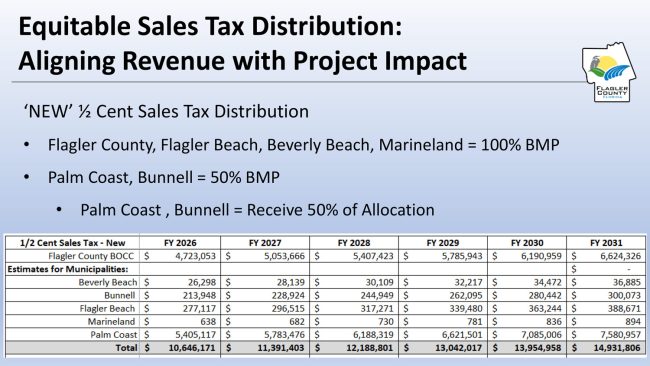
The numbers are not set in stone, in the sense that state or federal grants could reduce the local commitment, and unexpected storms could raise the cost. “Each year we’re going to have to reevaluate this fund,” Petito said.
There are many more details to the plan (see the documents in the bullet points below). But in essence, that’s it. That’s the plan Petito is presenting to local governments, ahead of the next joint government meeting on March 12, when the county hopes to hear more positive responses from Palm Coast, Bunnell and Flagler Beach.
“At the end of the day I’d like to see everybody on board,” Petito said. But it won’t be up to her. It’ll be up to the elected officials and their sense of shared responsibility, assuming they see the beach as such. So far, that has not been the case.
The Plan in Details:
- Flagler County’s Coastal Erosion and Management: Comprehensive Report
- Flagler County’s Coastal Erosion and Management: Executive Summary
- Flagler County’s Coastal Erosion and Management: Slide Presentation to Local Governments




















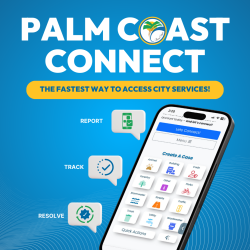

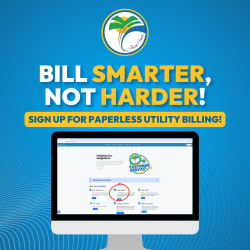






Nephew Of Uncle Sam says
“At a joint meeting of local governments on Feb. 5 Palm Coast and Beverly Beach, and to some extent Flagler Beach, bluntly rejected the county’s request for financial help to rebuild and maintain Flagler County’s beaches.”
1/2 cent sales tax no problem, yet if Beverly Beach and Flagler Beach still object then use the money to re-route A1A. At some point the sea will win.
Fernando Melendez says
I think it’s a reasonable plan put together by the county.
Ed Danko, former Vice-Mayor PC says
Third year in a row Flagler County has attempted a sales tax increase for one excuse or another. I urge all Palm Coast residents to show up at city hall and JUST SAY NO during public comment. We already have infrastructure and water treatment issues that will cost us mucho bucks.
Laurel says
Ed: Stay home.
Thomas Hutson says
Ok, so this crap is the secret plan our County Manager and Commissioners did not want the voters to see. Well now voters of Flagler County you see the secret, now let’s send them a Very, Very loud NO TAXES, HELL NO no more taxes. Just another huge waste of tax dollars., and by the way Big Daddy Warbucks cancelled all grants and special funding. Get rid of this County MANAGER AND COUNTY ATTORNEY, hey call King Trump’s right hand man, the nut case that jumped around with a chain saw like a wild man. Bet he could find money without raising taxes, just fire the fat cats at the top. One thing for sure, you don’t want Flagler County Government controlling anything, they have a very special way of wasting tax dollars.
Surfs up and so are the taxes says
The Petito Hansen plan is problematic. Shouldn’t be, but then again the county librarian is running the county according to Petito on the radio this week. What can go wrong?
Someone wake the county attorney up, he may want to weigh in on this or not. He seems to keep quiet in the most opportune times, throwing Shawn under the bus.
Endless dark money says
Why do they need more money now haven’t storms been around forever or are they more frequent and severe or something?plus the fascists ended fema, and govt funding so it all on the locals to pay for it? Maybe usaid will help haha. Y’all voted for greed over people right? Need to end the free old people insurance and social security since it’s insolvent! They can have the immigrants jobs haha! You know the ones at the concentration camps! Had to protect all those dogs and cats from being eaten haha.
Ray W, says
Florida’s Voice reports that at a press conference this morning, Governor DeSantis hinted that property taxes overall should go away:
“Is it your property or not? Just for being on your property, you’ve got to write a check to the government every year, so you’re basically paying rent to the government to live on your own property. … There’s homestead stuff that helps protect you to a certain extent, but you’re paying more, and a lot of people can’t afford that, so I think that’s a big issue, and I know that we’re going to be really looking at ways to bring people relief from that, because I think it’s been really something that’s pinching a lot of homeowners, particularly seniors on fixed incomes.”
Governor DeSantis also mentioned that the state’s new DOGE task force would use AI to eliminate more than 70 state boards and commissions and find wasteful spending in other departments. And, he said his administration would work with the legislature to pass a bill authorizing the “DOGE-ing of local governments.”
Make of this what you will.
Me? I have been around long enough to know that just about every time the executive branch says it will hire a new company to write software that will streamline government, the initial effort costs millions of dollars, and sometimes tens of millions of dollars, and it doesn’t work, because the best bidder was a Republican who knows nothing about writing code, but he or she contributes money to politicians. After the software fails, a second company is brought in to fix it, costing millions more in dollars.
Maybe Pogo is right. Maybe I am too sanguine, but after seeing millions and millions wasted every time a Republican politician says new software is needed, what the hell, let’s try it again. There’s nothing like hiring a prominent Republican contributor to oversee a statewide Attorney General’s database. When the attorneys I am zealously advocating against come into work one day to find that the last six months of their work has been deleted from their servers after a system crash, because the company had failed to build a subroutine into the program that would trigger a weekly backup of their work, you kind of remember the fact that the person didn’t know what he was doing when he got the lucrative contract. “Trust me”, he must have told those about to give him all those millions of dollars, “I will only hire the best.” When the regional AG office chief complained that all her lawyers had to start over from scratch to rebuild the last six months of their work, she was demoted.
celia pugliese says
No to Palmcoasters paying for beach front erosion as things are now should be a NO as Palmcoasters do not have a beach front property with a lifeguard for its residents that have to drive to Flagler Beach with its children to be under a lifeguard watch.
When Councilwoman Pontieri intended to request from the county to annex Malacompra park for Palmcoasters ocean front Parks and Recreation management inclusion was an outstanding NO opposition…Then let them pay for its restoration as Palm Coast does not have ocean front property because was exchanged by the county with Jim Draby chair in the late 90’s after ITT left us, to Bobby Ginns Hammock Beach state and golf course for 200 acres in the bundocks.”March 1998: The development order is amended to reduce the number of residential clusters to 35 (from 43) and shift some clusters’ locations. Residential acreage is increased from 888 to 916 acres. “More notably for the public, 33 acres of beachfront, public land, previously intended to be a public park, are conveyed to the developer to build a Jack Nicklaus signature golf course”. The golf course is intended to be a buffer between the development and the beach. The developer is still required to build a public park and preserve public access to the beach at the eastern end of 16th Road.” https://flaglerlive.com/hammock-dunes-timeline/#google_vignette .
We lost our ITT Sun Sports Resort membership ocean front pool and tennis courts in that nefarious county deal. But Ginn gave county $20,000 check for the publix access to beach (park?) great deal?
I was with others in that county 1998 meeting opposing the loss of our 33 acres ocean front public park with our ocean front pool and tennis courts, for 200 acres in the bundocks!. Then now we do not want to fund beach front repairs.
This is just like as always the county proceeds to take away our rights and have us pay up example also the new intended KFIN Airport Overlay Ordinance they want to pass over Palm Coast the largest stake holder in this county.file:///C:/Users/intam/Downloads/20250206-Flagler%20Executive%20Airport%20Overlay%20Ordinance-draft%20with%20line%20numbers%20(2).pdf
Anon says
A toll should be at Flagler beach bridge, like hammock dunes. Flagler beach residents can go over the non toll lane with a sticker and all others will pay to come over to use the beach.
RW says
For all those who believe that not having a usable beach to attract tourism and keep Palm Coast and other local cities whole are idiots. Palm Coast is not a High Tech or Mfg City. People come here to be in close proximity to great beaches and waterways. They advertise in Atlanta come visit “Palm Coast and the Flagler Beaches”! Yet people
like Ed Danko don’t want to protect the main feature why people move here or vacation! If they don’t want to pay for it, don’t come to the beach or if you do, face a steep charge. Watch how fast things change when the largest tax revenue base closes shop because they have no beach. I am talking about Hammock Beach resort. All those people who come into Palm Coast to shop and eat stop coming, all those rental dollars bring in money to Flagler Beach and Palm Coast. To not support your biggest revenue driver is just economic stupidly !
vance hoffman says
It’s pretty simple if you go with the plan you can possibly save the beach most people like. This will make lots of people mad. You can do nothing which alot of people like but will make alot of people mad. So I say let’s just make people happy and squeeze some money from the home builders we have 6 million new built homes every week. There i fixed it.
Carol says
I sit through a lot of county meetings, where was this presentation? I don’t recall the commissioners agreeing to any of this? Was this presented to the general public? I think I would recall them saying they would approve a 1/2 cent tax. So much for transparency.
John Stove says
Palm Coast…..NO and HELL NO to tax increase
We don’t have any money to fix our Waste Water Plant, Crumbling Roads, Salt Water Canals, Failing Utilities so they keep hitting us with “fees” so that they can say “we didn’t raise your taxes”……and now they want to tax us to fix the beach?
NO….take care of our issues first
Dennis C Rathsam says
Flagler Beach, pissing in the wind! You will never fix this problem with bandaids. The only real solution is to remove those homes across the street from the ocean, move the street back & build a proper sea wall. You folks been playing with this problem for many many years, & it hasn’t improved one bit. The more sand you add the more the ocean takes back. It’s a no win situation.Do you disrupt the few, for the sake of the many? Or do you continue to piss in the wind?
B says
Start charging for parking. Daytona is now charging 30 bucks for non resident and 20 bucks for residents to park to use the beach. I talked to 5 separate people the other day at varn park who drove up because they did not want to pay. No more taxes. I live on the barrier island and they want to charge me 160 dollars a year. Bullshit.
Laurel says
Let me see if I understand this correctly. As a barrier island resident, I have pay to get over the bridge (private Dunes bridge) to get home. I have to get in my car, drive to a public beach park and park my car to enjoy the beach, and pay $160 a year for this public privilege. Joe Shmoe, in Palm Coast, has to pay to drive over the bridge (private Dunes bridge) drive to a public beach park, and park his car to enjoy the beach, but does NOT have to pay $160 for the public privilege. Did I get that right? Will someone explain to me how this is reasonable?
My property is not subject to ocean flooding.
Now, it looks like I have to drive my car to a public beach, pay $160 a year for this public privilege, while people who live directly on the beach, can walk out their back doors, and enjoy a private beach for the same $160 per year. People who live in private subdivisions, on the beach, can walk to their private beach, for $160 per year for this private privilege. Did I get that right? Again, someone please explain this to me.
“Flagler County government’s proposed $114 million plan to rebuild, maintain and protect 18 miles of shoreline over the next six years depends on raising the local sales tax by half a penny, imposing a $160-a-year tax on each barrier island property, including Flagler Beach…” Just exactly what does “$160 tax on each barrier island property” mean? Are they taxing each condo unit, or are the condo buildings “one property?” Are the businesses, regardless of size, or tourist income, still “one property?” Would a hotel, such as Margaritaville, or motel be considered “one property?” Please inform me, because there are a whole lot of units on “one property,” in the Dunes, and other commercial properties, a significant amount of which are tourist vacation rentals, and tourist businesses.
Please explain, because it sounds like a whole lot of preferential treatment going on.
Also, because I’m not so up to date on taxing procedures, don’t I pay for beach park upkeep? Won’t I be paying sales taxes? Won’t I be paying for a tax overlay? What is that, single taxing, double taxing, or even triple taxing? I’m not sure. Please explain.
What I do understand is, this plan is one hell of a good deal for a select group of people living directly on the beach, for commercial tourist businesses, and for Palm Coast city residents, where the housing boom continues, but not so much for the residents on the barrier island who do not live on the ocean, many of whom cannot afford to pay for others’ beach privileges.
And Petito, and Hansen, neither of whom are barrier island residents, wants us to all “get on board.” They continue to plan a disproportionate, unreasonable charge.
Also, Hammock Community Association is interestingly quiet on the subject. What say you?
A lot of questions, I would appreciate a lot of answers.
Laurel says
I should quote “each property” instead of “one property” but it means the same thing. I need a definition of “$160 for each property.”
Ed's a lucky charm peddler says
Ed Danko….silly rabbit. YOU were part of the problem as to WHY we have water and infrastructure issues. You’ve never met a development that you could say no to. How did you think they would get water and roads without raising taxes? What a LOON.
Mothersworry says
Hmmmm…….. In FB we pay huge base water bills. We pay those bills whether we are here or not. When our residence was destroyed in the last hurricane we paid a monthly water and trash bill. Nobody could live in the home for over a year. The trash truck drove by and waved. But we paid. Now, another bill?? Do what Daytona does, charge for the use. Charging a senior citizen in PC for a beach he can’t get to due to these new steep crossovers is nuts! Are business’s going to pay more as they take up most of the downtown parking? If the beach wasn’t here would these restaurants and bars be here? Nope! You have people on fixed incomes that are going to be fee’d out of their homes if this BS continues.
celia pugliese says
RW if not for ITT-Levitt Palm Coast IDC largest ever development in the 1970’s in this county, may have still been a swamp! So lest give credit were credit due while Palm Coast contributes 44 cents from every dollar in the ad valorem taxes to it! Like our cleaver and realistic Mayor Norris said what about annexing the airport and as far is my concern should be a go, so we can boot the no revenue for us flight schools (as the airport in the read yearly by one to two millions) and we in the ground endure the nuisance, danger and deteriorated value of our homes. County gave away blocks ocean front all 33 acres of our public park in the DRI to Bobby Ginn for the Hammock Beach and its Nicklaus Golf Course ocean front in 1998, so now pay up the cost of beach erosion then. We Palm Coaster do not have a Beach Front Lifeguarded beach and have to drive to FB if we want one and we are the largest stake holder in this county like Mayor Norris said, exactly! Thank you to our Mayor Norris, Vice Mayor Pontieri and Councilmen Miller and Stevens for opinions!
Leslie Gomillion-Cushing says
We must have our beaches maintained for all of us and for revenue. If you don’t like what is proposed come up with a different plan. Not taking care of our beach is not an option. So instead of complaining go to the council meetings and contribute to the solution.
Steve says
Several ideas are ok. The sales tax hits the best: residents, pass thru folks, and tourists. Tourism funds are definitely ok.
Not ok – island residents only pay the $160 a year! As someone else mentioned, does the mean renters, businesses (large and small) just $160? Condo owners (each one).
This one seems to me to need to be refigured. All Flagler County residents paying would drop that yearly amount down quite a bit. Large business would seem to need a different figure as they have more potential feet on the beach!
Also, not sure why Palm Coast and Bunnel would keep sales tax dollars from the increase?
Keep discussing with the residents about revenue streams live!
Not decide and then tell us what we are going to do.
Dbhammock says
I’ve said it before and I’ll say it again, the beach is a county asset just like schools, parks, roads and other infrastructure and should be treated as such. When you need money for schools do only people who have kids lay the increased property taxes. No. When you develop a dog park or bike trail do the people who use the park or bike trail pay the cost of the park or bike trail. No. I could go on and on. This is a slippery slope which could lead to a whole new paradigm in county finances and beach usage, fees for parking etc . Whatever the so,it in is, it must be a County so,union, for all residents of the county, not a tax in those who live close to the beach.
Donald Trump says
Not another penny until OKR is widened. The asshole in city hall just approved another 113 units that the city has no capacity for water or sewage. We need a clean sweep of all city employees, bring in new folks at lower salaries, use the savings for required projects. We have 57 city employees making $20ok a year including salary, pensions medical, and other benefits.